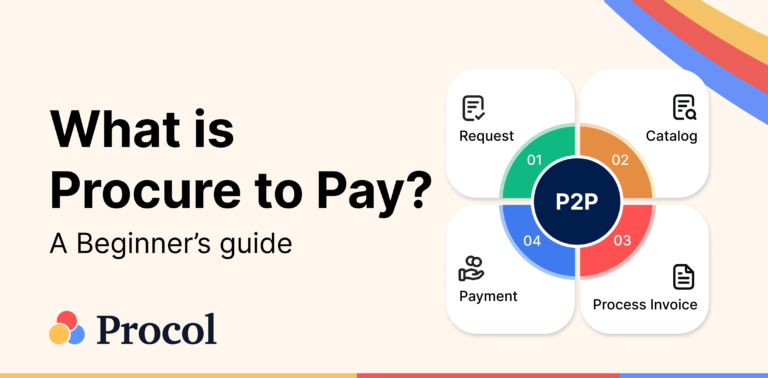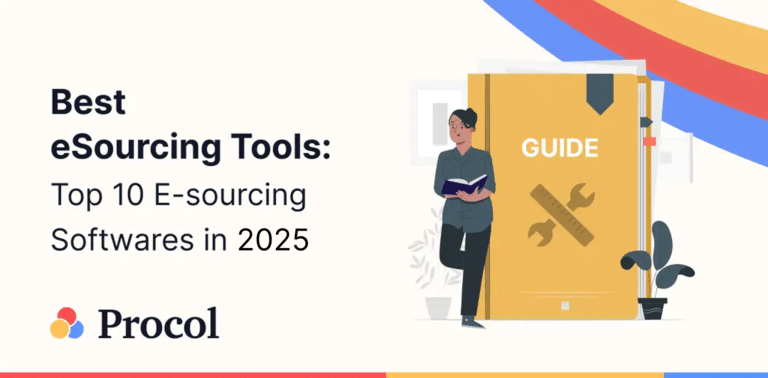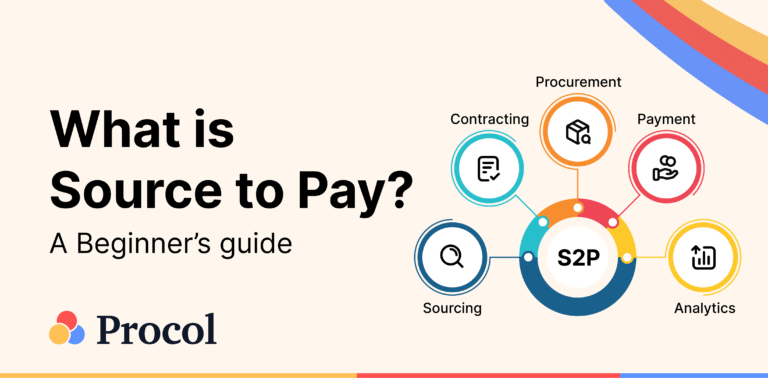Procol • April 15, 2025
Tail Spend Analysis: What is it and How to perform it

Introduction
In the world of procurement, there’s a term known as ‘tail spend’. This refers to the numerous small-scale transactions that, while individually low in value, collectively account for a significant portion of an organization’s overall expenditure. These transactions are often ad hoc and uncategorized, making them difficult to manage.
The Pareto Principle, also known as the 80/20 rule, is often applied to this scenario. It suggests that 80% of total spend is made with only 20% of the vendors, leaving the remaining 20% of the spend (which consists of high-volume, low-value transactions) to 80% of the vendors. This 20% value is referred to as ‘tail spend’.
What is tail spend analysis?
Tail spend analysis is the process of examining this spending to identify inefficiencies and potential savings. It’s a crucial aspect of procurement strategy, offering opportunities for cost optimization and risk mitigation. Effectively managing tail spend can lead to substantial savings, making it a hidden treasure in cost management. Tail spend is often referred to as unmanageable purchases within a company. Despite their low value, collectively, they account for a significant portion of total expenditure. Generally, it is 20% of the total value spent that’s made with 80% of merchants.
What are the benefits of Tail Spend Analysis?
A business can have multiple benefits if it uses tail-end spend analysis. It helps growing and established businesses carefully study and analyze spending trends, which can be forecasted, to explore various business metrics and help the business better utilize its monetary resources.
The analysis done using the tail spend technique provides concrete results, enabling the business to identify opportunities for cost-cutting and resource standardization. These results can help a business remain effective in the market and improve its profit margin.
Below are some additional benefits of tail spend management:
- Increase productivity of the company
- Enhances the quality of data
- Configures management spending
- Helps save overall company cost
- Reduces the risk to merchants
What are the best practices for Tail Spend Analysis?
Just like any other analysis tool, some things must be kept in mind while incorporating tail spend analysis into your business:
- Make sure you have set your goals and intentions
- Skillfully define the scope of your business analysis
- Examine the sources that you have
- Spot the weaknesses and extra spending
- Track your spends
- Use the insights to improve your overall process efficiency
What are some important metrics for Tail Spend Analysis?
Metrics for tail end spend analysis are the key indicators used to evaluate the effectiveness of tail spend management. These metrics provide a clear picture of progress and areas for improvement. They include:
- Cost savings: The reduction in expenditure achieved.
- Number of suppliers used: Helps identify supplier consolidation opportunities.
- Number of contracts renegotiated: Indicates successful contract management.
- Number of items consolidated and standardized: Shows efficiency in managing purchases.
- Transaction costs and spend visibility: Evaluates the cost-effectiveness and transparency of transactions.
These metrics help organizations track their efficiency, optimize spending, and uncover hidden savings opportunities in the tail spend.
How to manage tail spend in five steps?
1. Recognize your tail spend
The first step is to define what tail spend means in your organization. This involves understanding the nature of your procurement activities and identifying which transactions fall into the tail spend category. It’s about recognizing the small, often overlooked purchases that, when added up, represent a significant portion of your total expenditure.
2. Streamline internal processes
Once you’ve identified your tail spend, the next step is to streamline your procurement processes. This involves ensuring that your procurement procedures are clear, well-communicated, and consistently enforced. Streamlining these processes can help prevent maverick spending and ensure that all purchases are made in a controlled and efficient manner.
3. Classify the data
The third step involves organizing your procurement data for analysis. This includes collecting data from various sources, cleaning it, and structuring it in a way that facilitates easy analysis. Having well-organized data is crucial for gaining insights into your tail spend.
4. Leverage insights
The fourth step is to use the insights gained from your data analysis to make informed decisions. This could involve identifying patterns in your tail spend, spotting opportunities for savings, and making strategic decisions based on these insights.
5. Track the benefits
The final step is to establish metrics to track the progress and benefits of your tail spend management efforts. This involves monitoring your cost savings, supplier consolidation, contract renegotiations, and other key indicators of success. By tracking these metrics, you can measure the effectiveness of your tail spend management strategy and make necessary adjustments.
In conclusion, managing tail spend is a multi-step process that involves identifying tail spend, streamlining processes, organizing data, using the insights gained, and monitoring the benefits. By following these steps, organizations can gain control over their tail spend, leading to significant cost savings and efficiency improvements.
How can Procol help you manage tail spend?
Procol offers a comprehensive solution to manage tail spend effectively enabling businesses to handle end-to-end tail spend management processes. Its user-friendly interface, effective reporting and analytics, and valuable insights make Procol a preferable choice among various tail spend management software.
Founded in 2018, Procol is India’s ideal tail spend management software company that has been securely deployed at many $1B global companies. It has various unmatched features and capabilities that make it the best tail spend management software for your system.
Why Procol is the best tail spend management software company?
- Next-generation platform to get all your spending under control and ultimately gain 2-10% cost savings.
- $100M+ generated savings by Procol customers.
- Empower teams with a dedicated mobile-first approach. It ensures tail spend professionals have the flexibility they need to drive efficiency wherever they are.
- Businesses gain the flexibility of customizable workflows and templates that meet precise organizational needs.
- Gives access to 50,000+ suppliers registered and onboarded globally.
- Intuitive interface and unmatched efficiency ensure quick setup.
- Streamlines capex sourcing for maximum efficiency.
In essence, Procol provides a comprehensive tail spend management solution that empowers your procurement team, unlocks industry-leading efficiencies, and provides clarity in every transaction1. By leveraging Procol’s platform, organizations can manage their tail spend more efficiently, leading to significant cost savings and efficiency improvements.
How to automate tail spend analysis?
Automating tail end spend analysis and tracking tail spend analytics can be a game-changer for organizations, enabling them to manage their procurement more efficiently. Below is a step-by-step guide that will surely help you understand the process effectively:
1. Identify tail spend
Start by defining and identifying your organization’s tail spend. This involves understanding your procurement activities and determining which transactions fall into the tail spend category.
2. Streamline processes
Streamline your procurement processes, including process automation. Clear, well-communicated, and consistently enforced procedures can help prevent maverick spending and ensure controlled and efficient purchases.
3. Organize data
Collect and organize procurement data for analysis. This includes data from various sources, such as supplier invoices, purchase orders, contracts, and other financial documents.
4. Use insights
Use the insights gained from your data analysis to make informed decisions. This could involve identifying patterns in your tail spend, spotting opportunities for savings, and making strategic decisions based on these insights.
5. Track benefits
Establish metrics to track the progress and benefits of your tail spend management efforts. By tracking these metrics, you can measure the effectiveness of your tail spend management strategy and make necessary adjustments.
6. Leverage technology
Use technologies such as automated sourcing platforms, which can be connected to your P2P or ERP system. This can help automate the tail spend analysis process, making it more efficient and effective.
Conclusion
In conclusion, automating tail spend analytics involves a combination of identifying tail spend, streamlining processes, organizing data, using insights, monitoring benefits, and leveraging technology. By following these steps, organizations can manage their tail spend more efficiently, leading to significant cost savings and efficiency improvements.
Explore more from Procol
Discover expert tips, how-to guides, industry insights, and the latest procurement trends.

What is Procure-to-pay (P2P)? An Ultimate Guide
Procure to pay is the process from procurement of materials needed...

Best eSourcing Tools: Top 10 eSourcing Software in 2025
Discover top 10 e-sourcing tools and esourcing platforms necessary for efficient...

What is Source-to-pay in 2025? An Ultimate Guide
Source to pay is the process of sourcing vendors to procure...



















